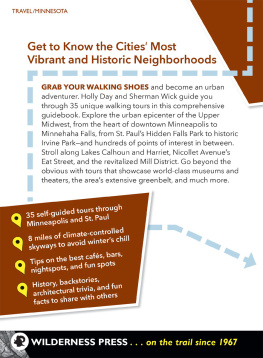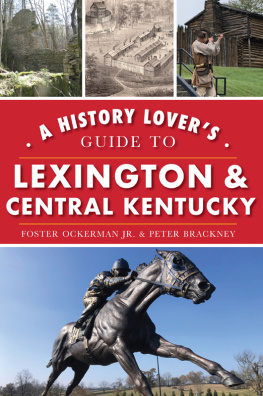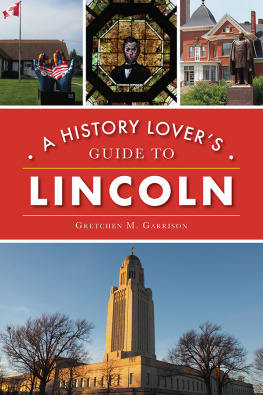Sherman Wick - A History Lovers Guide to Minneapolis (History & Guide)
Here you can read online Sherman Wick - A History Lovers Guide to Minneapolis (History & Guide) full text of the book (entire story) in english for free. Download pdf and epub, get meaning, cover and reviews about this ebook. year: 2019, publisher: Arcadia Publishing Inc., genre: Non-fiction. Description of the work, (preface) as well as reviews are available. Best literature library LitArk.com created for fans of good reading and offers a wide selection of genres:
Romance novel
Science fiction
Adventure
Detective
Science
History
Home and family
Prose
Art
Politics
Computer
Non-fiction
Religion
Business
Children
Humor
Choose a favorite category and find really read worthwhile books. Enjoy immersion in the world of imagination, feel the emotions of the characters or learn something new for yourself, make an fascinating discovery.
- Book:A History Lovers Guide to Minneapolis (History & Guide)
- Author:
- Publisher:Arcadia Publishing Inc.
- Genre:
- Year:2019
- Rating:4 / 5
- Favourites:Add to favourites
- Your mark:
- 80
- 1
- 2
- 3
- 4
- 5
A History Lovers Guide to Minneapolis (History & Guide): summary, description and annotation
We offer to read an annotation, description, summary or preface (depends on what the author of the book "A History Lovers Guide to Minneapolis (History & Guide)" wrote himself). If you haven't found the necessary information about the book — write in the comments, we will try to find it.
Sherman Wick: author's other books
Who wrote A History Lovers Guide to Minneapolis (History & Guide)? Find out the surname, the name of the author of the book and a list of all author's works by series.
A History Lovers Guide to Minneapolis (History & Guide) — read online for free the complete book (whole text) full work
Below is the text of the book, divided by pages. System saving the place of the last page read, allows you to conveniently read the book "A History Lovers Guide to Minneapolis (History & Guide)" online for free, without having to search again every time where you left off. Put a bookmark, and you can go to the page where you finished reading at any time.
Font size:
Interval:
Bookmark:


Published by The History Press
Charleston, SC
www.historypress.com
Copyright 2019 by Sherman Wick and Holly Day
All rights reserved
Cover images from the Library of Congress. All other photos by Sherman Wick.
First published 2019
E-book edition 2019
ISBN 978.1.43966.864.1
Library of Congress Control Number: 2019913833
Print Edition ISBN 978.1.46714.193.2
Notice: The information in this book is true and complete to the best of our knowledge. It is offered without guarantee on the part of the authors or The History Press. The authors and The History Press disclaim all liability in connection with the use of this book.
All rights reserved. No part of this book may be reproduced or transmitted in any form whatsoever without prior written permission from the publisher except in the case of brief quotations embodied in critical articles and reviews.
To our mothers, Rita and Elvy.
CONTENTS
PREFACE
Minneapolis is a city of seasons. Regardless of the extremes of the weather, events are paramount and celebrated amid the festive chill and persistent flurries of the annual Holidazzle or the sultriness midsummer of the Aquatennial. The citys landmarks define the topography of Minneapolisthe Chain of Lakes, Spoonbridge and Cherry, the Stone Arch Bridge, the Hennepin Avenue Bridge, the Foshay Tower and the IDS Centerand cast shadows throughout the City of Lakes or the Mill City. For Minneapolis, both municipal mottos reveal the citys history.
The water of the powerful Mississippi River runs throughout the historical genesis of Minneapolis. Surpassing St. Louis in flour production was impossible without the Falls of St. Anthony, a seemingly infinite natural hydrological power source. But the unattainable goal was accomplished in 1880. Minneapolis prevaileda position retained for fifty years. Moreover, Minneapolis, in the 1870s, exceeded St. Paul in manufacturing. Minneapolis became the most populous city in the Upper Midwest.
I arrived in Minneapolis to attend the University of Minnesota almost thirty years ago. And Minneapolis was the place to be, for me, with the recently defunct Hsker D and the legendary Replacements. Holly came here on a job offer that fell through and stayed because she had family in the area. Together, weve written several books about Minneapolis and nearby St. Paul.
At the end of each chapter, Your Guide to History is arranged alphabetically except in some obvious cases for convenience.
This book would be impossible without the resources available at the Minneapolis Central Library and the Minnesota Historical Society.
MILL CITY TO CITY OF LAKES
Before steam power was fully developed, the Falls of St. Anthony, the sole waterfall on the Mississippi River, provided the chief source of energy in the region. The duality of the Falls, both as a natural attraction and as an energy resource, recalibrated increasingly to the latter.
The Falls attracted explorers and travelers with its astonishing riverine beauty. One noteworthy traveler was Henry David Thoreau (18071862). Afflicted with tuberculosis, commonly known as consumption, he would die the following year. When Thoreau visited, accompanied by botanist Horace Mann Jr., the nineteen-year-old son of the Father of the American education, the Falls of St. Anthonys natural beauty was uncompromised. The year 1861 was pivotal, just before the Civil War and after the Panic of 1857, which had destroyed the local and national economy. The trip was Thoreaus longest journeyover 3,500 miles. Thoreau was an influential leader of the Transcendentalist movement that began in the 1820s and 1830s, and his philosophy was influenced by Platonism, romanticism and Kantian philosophy. The poet, philosopher and essayist never formally wrote about the area. But he did draft journals and letters while traveling with state geologist Dr. Charles Anderson.
In March 1935, John T. Flanagan wrote in Minnesota History Magazine, Together they roamed through the woods and around the shores of Lake Calhoun, botanizing and culling specimens of plant and animal life. Thoreau enjoyed the grandeur of the lakes while also noting the prodigious profusion of mosquitoes and ticks despite his perspective emphasizing common space over commodity and property. It is obvious that Thoreau viewed the settlements along the upper Mississippi not as hamlets struggling to achieve fame and prosperity, but as happy hunting grounds for naturalist and wanderer who had hitherto been limited to a different terrain with other flora and fauna, wrote Flanagan.

Mill City Museum.
Thoreau hoped to chronicle the natural elegance of the Falls of St. Anthony. But he failed to consult the local Native Americansthe Dakota and the Ojibwe. In the aftermath of the Dakota War, the Dakota and Ojibwe were exiled to Nebraska and South Dakota after the public hanging of thirty-eight Dakota in Mankato on December 26, 1862. The forced removal of the Native Americans opened the falls for lumber milling. Over decades, industrialization was an ongoing process. The milling elites, first, turned away from the river to the lakes, and the Mill City ascended as the nations flour milling center. The islands around the falls were modified, reshaped orin the case of Spirit Islandeventually erased from the map.
Spirit Island, or Wanagiyata to the Dakota, was located north of the old Lower Bridge (18571934) immediately downriver from the Stone Arch Bridge. Before settlement, the Army Corps of Engineers viewed Spirit Island as a channel obstruction to the falls. Composed physically of a St. Peter sandstone base with a limestone cap, the island was eroded away by industrial use.
Jonathan Carver described the island in Travels Through America 17661768: At a little distance below the Falls stands a small island of about an acre and a half on which grow a great number of oak trees, every branch of which, able to support the weight, was full of eagles nests. In 1849, Swedish novelist and feminist Fredrika Bremer also discussed the significance of Spirit Island. After she visited St. Anthony, even if she shared some of the racist views of the time, she did appreciate the culture of the American Indians.
First St. Anthony and then Minneapolis were platted on the river. Sawmilling and, later, flour milling built the two cities that merged in 1872. Successive waves of immigrants arrived to fill jobs in the flourishing milling and numerous allied industrial fields. The citys population swelled while reestablished boundaries expanded. From 1880 to 1930, Minneapolis quickly claimed the position of commercial and cultural capital of the Upper Midwest.
Spirit Island continued to be mined away, while Cataract and Upton Islands also vanished with navigation improvement projects by the Army Corps of Engineers at the Upper Mississippi Harbor. Spirit Islands disappearance was chronicled in the Hennepin County History Magazine in the spring 1960 issue, while the history was bereft of the American Indians story.

The Falls of St. Anthony and the old Mill District.
In the decades before urban renewal, the vicinity of the falls was largely industrial. However, Nicollet Island was forty acres of residences, commercial and industrial buildings and De La Salle High School. The Lower Dam submerged Cataract Island. Finally, the fifteen acres of Hennepin Island was, as
Next pageFont size:
Interval:
Bookmark:
Similar books «A History Lovers Guide to Minneapolis (History & Guide)»
Look at similar books to A History Lovers Guide to Minneapolis (History & Guide). We have selected literature similar in name and meaning in the hope of providing readers with more options to find new, interesting, not yet read works.
Discussion, reviews of the book A History Lovers Guide to Minneapolis (History & Guide) and just readers' own opinions. Leave your comments, write what you think about the work, its meaning or the main characters. Specify what exactly you liked and what you didn't like, and why you think so.






